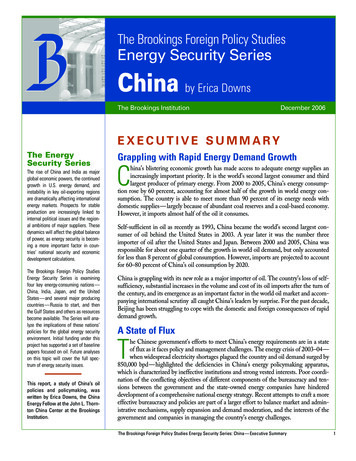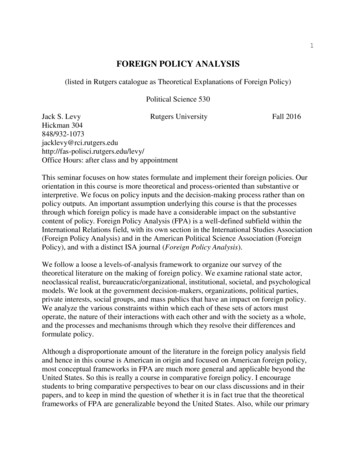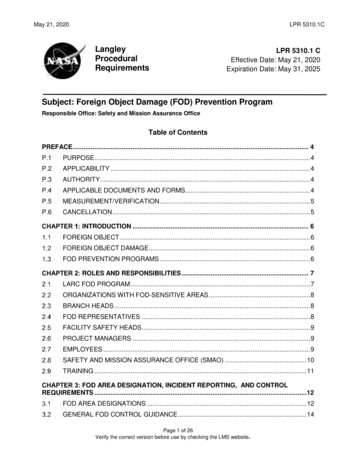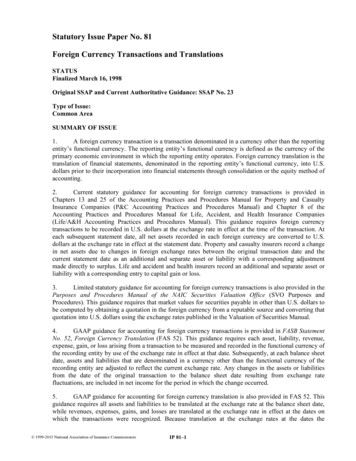
Transcription
The Brookings Foreign Policy StudiesEnergy Security SeriesChina by Erica DownsThe Brookings InstitutionDecember 2006EXECUTIVE SUMMARYThe EnergySecurity SeriesThe rise of China and India as majorglobal economic powers, the continuedgrowth in U.S. energy demand, andinstability in key oil-exporting regionsare dramatically affecting internationalenergy markets. Prospects for stableproduction are increasingly linked tointernal political issues and the regional ambitions of major suppliers. Thesedynamics will affect the global balanceof power, as energy security is becoming a more important factor in countries’ national security and economicdevelopment calculations.The Brookings Foreign Policy StudiesEnergy Security Series is examiningfour key energy-consuming nations—China, India, Japan, and the UnitedStates—and several major producingcountries—Russia to start, and thenthe Gulf States and others as resourcesbecome available. The Series will analyze the implications of these nations’policies for the global energy securityenvironment. Initial funding under thisproject has supported a set of baselinepapers focused on oil. Future analyseson this topic will cover the full spectrum of energy security issues.This report, a study of China’s oilpolicies and policymaking, waswritten by Erica Downs, the ChinaEnergy Fellow at the John L. Thornton China Center at the BrookingsInstitution.Grappling with Rapid Energy Demand GrowthChina’s blistering economic growth has made access to adequate energy supplies anincreasingly important priority. It is the world’s second largest consumer and thirdlargest producer of primary energy. From 2000 to 2005, China’s energy consumption rose by 60 percent, accounting for almost half of the growth in world energy consumption. The country is able to meet more than 90 percent of its energy needs withdomestic supplies—largely because of abundant coal reserves and a coal-based economy.However, it imports almost half of the oil it consumes.Self-sufficient in oil as recently as 1993, China became the world’s second largest consumer of oil behind the United States in 2003. A year later it was the number threeimporter of oil after the United States and Japan. Between 2000 and 2005, China wasresponsible for about one quarter of the growth in world oil demand, but only accountedfor less than 8 percent of global consumption. However, imports are projected to accountfor 60–80 percent of China’s oil consumption by 2020.China is grappling with its new role as a major importer of oil. The country’s loss of selfsufficiency, substantial increases in the volume and cost of its oil imports after the turn ofthe century, and its emergence as an important factor in the world oil market and accompanying international scrutiny all caught China’s leaders by surprise. For the past decade,Beijing has been struggling to cope with the domestic and foreign consequences of rapiddemand growth.A State of FluxThe Chinese government’s efforts to meet China’s energy requirements are in a stateof flux as it faces policy and management challenges. The energy crisis of 2003–04—when widespread electricity shortages plagued the country and oil demand surged by850,000 bpd—highlighted the deficiencies in China’s energy policymaking apparatus,which is characterized by ineffective institutions and strong vested interests. Poor coordination of the conflicting objectives of different components of the bureaucracy and tensions between the government and the state-owned energy companies have hindereddevelopment of a comprehensive national energy strategy. Recent attempts to craft a moreeffective bureaucracy and policies are part of a larger effort to balance market and administrative mechanisms, supply expansion and demand moderation, and the interests of thegovernment and companies in managing the country’s energy challenges.The Brookings Foreign Policy Studies Energy Security Series: China—Executive Summary1
For the past decade,Beijing has beenstruggling to copewith the domesticand foreignconsequences ofrapid demandgrowth. This monograph examines China’s approach to energy security. It focuses on oil becauseit is presently the only fuel that China imports in substantial quantities, and consequently,the fuel China is most concerned about securing. Oil is also increasingly influencingChina’s international behavior. The paper is divided into five sections. Sections 1 and 2assess the country’s energy balance and Chinese conceptions of energy security. Section 3analyzes how China’s policymaking apparatus has undermined the country’s ability tocope with rapid energy demand growth; it explores the likely impact of recent institutional changes to address this problem. Section 4 analyzes specific policies and projects tomoderate demand and increase supply. Section 5 discusses the implications of China’s oilpolicies domestically and internationally. A number of key findings result: The establishment in 2005 of the Energy Leading Group—a supraministerial coordinating body headed by Premier Wen Jiabao—signified the leadership’s dissatisfaction with China’s energy policymaking apparatus, but it is unlikely to solve all of theproblems that hamper energy sector management. These include manpower andfunding shortages in policymaking and statistical bodies, the influence of state energyfirms, and inadequate institutional arrangements to coordinate conflicting interests. The government will continue its struggle to balance the use of administrative andmarket mechanisms in the energy sector. Beijing will continue to adjust the caps ongasoline and diesel prices toward international levels, but will do so gradually becauseof concerns about the impact on economic growth and social stability. There has been a major shift—at least rhetorically—in China’s approach to energydevelopment in recent years, with the leadership placing greater emphasis on demandmoderation. However, China’s fractured energy policymaking apparatus and the lackof a bureaucratic champion for demand moderation to counterbalance the interests ofthe powerful state-owned energy companies in supply expansion pose a challenge tothe government’s ambitious energy conservation targets.he Brookings Institution is a private nonprofit organization devoted to independent research and innovative policy solutions. Celebrating its90th anniversary in 2006, Brookingsanalyzes current and emerging issuesand produces new ideas that matter—for the nation and the world. Forpolicymakers and the media, Brookings scholars provide the highestquality research, policy recommendations, and analysis on the full range ofpublic policy issues.T The relationship between the government and China’s national oil companies (NOCs)will be characterized by increased friction at home and improved coordination abroad.Domestically, the NOCs will continue to seek greater autonomy from the government. Internationally, the recent trend of greater coordination between the NOCsand the government will continue, with Beijing employing political and financial toolsto help firms acquire trade and investment opportunities. Public debate on energy security indicates that some participants question the relationship between the foreign investments of China’s NOCs and the country’s energysecurity. More Chinese analysts now argue that the acquisition of equity oil will dolittle to help China deal with supply disruptions. Beijing is increasingly aware that domestic energy security is linked to internationalenergy security. But there is no agreement as to the role China should play in globaland regional initiatives and institutions that facilitate cooperation among oil importers. China’s oil interests, like those of other countries, will continue to shape its broaderforeign policy. Beijing is probably more willing to take actions to gain and maintainaccess to oil that run afoul of U.S. interests when those interests are not top U.S. foreign policy objectives.The Brookings Foreign Policy Studies Energy Security Series: China—Executive Summary2
The Brookings Foreign Policy StudiesEnergy Security SeriesChinaBy Erica DownsContentsExecutive Summary . 1Grappling with Rapid Energy Demand Growth . 1A State of Flux. 1Acronyms . 5Introduction . 6Part 1. China’s Energy Balance . 8Oil Demand . 9Domestic Oil Supply . 10Oil Imports . 10Natural Gas . 11Coal and Other Fuels . 12Part 2. What Does Energy Security Mean in China?. 13Adequate Supplies . 13Reasonable Prices . 13Safe Delivery of Imports. 14The Changing Energy Security Debate . 14Part 3. China’s Energy Policymaking Apparatus:Ineffective Institutions and Powerful Firms. 16Ineffective Institutions. 16The Energy Bureau . 18The Energy Leading Group and the State Energy Office . 19Powerful Firms . 21Impact of Ineffective Institutions and Powerful Firms on Energy Policy . 24Part 4. Oil Projects and Policies. 25Demand Side . 26Oil Price Reform. 26Fuel Tax . 28Other Measures to Slow Oil Demand Growth in Road Transport. 29Supply Side . 30Diversification of Oil Suppliers and Transport Routes . 30Kazakhstan-China Oil Pipeline . 32Russia-China Oil Pipeline . 34The Brookings Foreign Policy Studies Energy Security Series: China3
Acquisition of Equity Stakes in Oil Exploration and Production Assets Abroad . 35Multiple Motivations Propel China’s Oil Companies Overseas . 35The Origins of “Going Abroad” . 38Government-Industry Interaction . 39Foreign Oil Assets: Facts and Figures . 43Where is the Foreign Equity Oil Produced by China’s NOCs Sold? . 43Strategic Petroleum Reserve . 44Part 5. Conclusion . 48State versus Market . 48Supply Expansion versus Demand Management. 49The Government versus the NOCs . 49Multilateral versus Bilateral Cooperation. 49Foreign Policy Radicalization versus Moderation. 50Endnotes. 52FiguresFigure 1. China's Total Primary Energy Consumption, 2000–2005 . 8Figure 2. Incremental Growth in Chinese and Global Primary EnergyConsumption, 2000–2005 . 8Figure 3. China’s Oil Demand, 1995–2005. 9Figure 4. China’s Oil Demand and Domestic Supply, 1990–2005 . 10Figure 5. China’s Primary Energy Demand, 2002 and 2020. 12Figure 6. Selected Components of China’s Energy Bureaucracy. 18Figure 7. Weekly Retail Gasoline Prices in Selected Countries,January 2003–October 2006 . 27Figure 8. China’s Crude Imports by Region, 1995 and 2005 . 31Figure 9. China’s Crude Imports by Country, 2005 . 31TablesTable 1. Projections of China’s Oil Demand in 2020 (million barrels per day). 9Table 2. Projections of China’s Oil Supply in 2020 (million barrels per day) . 10Table 3. Projections of China’s Natural Gas Demand in 2020 (billion cubic meters) . 11Table 4. Projections of China’s Natural Gas Supply in 2020 (billion cubic meters) . 11Table 5. China’s Energy Leading Group, May 2005 . 19Table 6. Sections of the Kazakhstan-China Oil Pipeline . 32Table 7. Selected Countries in Which China’s Oil CompaniesHave Signed Contracts for Equity Participation . 43Table 8. Chinese Oil Companies’ Foreign Equity Oil Production by Country, 2004. 43Table 9. Chinese Oil Companies’ Foreign Equity Oil Production by Company, 2004 . 43The Brookings Foreign Policy Studies Energy Security Series: China4
Acronymsbcmbillion cubic metersbpdbarrels per dayCAFÉCorporate Average Fuel EconomyCCPChinese Communist PartyCNPCChina National Petroleum CorporationCNOOCChina National Offshore Oil CorporationCPSCentral Party SchoolEIAU.S. Energy Information AgencyELGEnergy Leading GroupGDPgross domestic productIEAInternational Energy AgencykmkilometerLNGliquefied natural gasMFAMinistry of Foreign AffairsMOEMinistry of Energympgmiles per gallonNDRCNational Development and Reform CommissionNOCsnational oil companiesNPCNational People’s CongressSECState Energy CommissionSEOState Energy OfficeSETCState Economic and Trade CommissionSinopecChina Petroleum and Chemical CorporationSPRstrategic petroleum reserveUNSCUnited Nations Security CouncilThe Brookings Foreign Policy Studies Energy Security Series: China5
IntroductionUntil 1993 China was self-sufficient in meeting its energy needs. A decade later it hadbecome the world’s second largest consumer of oil behind the United States, and by2004, the world’s third largest importer of oil after the United States and Japan. WhileChina accounted for less than 8 percent of global oil consumption between 2000 and 2005,it was responsible for 27 percent of the growth in global oil consumption over that period.1This demand growth has contributed to oil’s increasing prominence on Beijing’s domesticand foreign policy agendas.China’s emergence as a major oil importer surprised its leadership. When Premier ZhuRongji abolished the country’s Ministry of Energy (MOE) in 1993—on the eve of China’stransition to a net oil importer—he and his colleagues expected that the country would continue to be energy self-sufficient.2 The substantial increase in both the volume and cost ofits oil imports that began at the turn of the century also caught the Chinese leadership offguard. Over the past decade, the Chinese have struggled to cope with the domestic andinternational ramifications of this demand growth, prompting changes in the country’senergy bureaucracy and its approaches to ensuring that its oil requirements are met.In recent years the government has grappled with reform of its energy policymaking apparatus, which some Chinese analysts consider a threat to the country’s energy security. China’senergy bureaucracy is characterized by ineffective institutions and strong vested interests.Poor coordination and conflicting objectives among the bureaucracy’s different componentshave impeded development of a single national energy strategy. Energy policies are madepiecemeal and are often shaped by powerful stakeholders’ interests. China’s influential stateowned energy companies—especially the oil firms—have considerable impact on energysector development because they possess the political, financial and human resources that theenergy policymaking bodies lack.The energy crisis of 2003–04 was a catalyst for change in China’s energy bureaucracy. Thecountry suffered widespread power shortages, which contributed to a substantial increase inoil demand and imports as diesel generators were run to maintain power. In 2004 blackoutsplagued twenty-four out of thirty-one of China’s provinces. Oil demand grew by 15 percent(850,000 barrels per day [bpd])3 and net imports of crude and refined products by almost 50percent (900,000 bpd).4 The power shortages and surge in oil demand and imports served asan indictment of China’s energy sector management. In 2005 the formation of the EnergyLeading Group (ELG) headed by Premier Wen Jiabao and its administrative body, the StateEnergy Office (SEO), signified the leadership’s dissatisfaction with China’s energy policymaking apparatus. But it fell short of the creation of an authoritative, independent, and wellstaffed ministerial-level agency to oversee the energy sector. The need for such an entitycontinues to be the subject of intense debate within Chinese energy circles.China’s approach to meeting its oil requirements is also in flux. First, the Chinese leadership is committed—at least rhetorically and apparently muchmore than in the past—to placing equal emphasis on demand moderation and supplyThe Brookings Foreign Policy Studies Energy Security Series: China6
expansion. Achieving this objective will require overcoming some of the obstacles thathistorically have hampered demand-side management in China. These include theabsence of a bureaucratic champion for energy conservation to balance against theinfluence of the powerful state-owned energy companies, which have a vested interestin supply expansion and a reluctance to shoulder the political and economic costs ofpolicies aimed at slowing energy demand growth, such as increasing fuel prices. Second, the Chinese government is reassessing its roles in the domestic and international oil markets. Domestically, oil shortages in Guangdong Province in the summerof 2005—rooted in oil product prices that were substantially below those on the international market—forced Chinese officials to acknowledge, albeit obliquely, the difficulties in maintaining price controls for a country that imports almost half of its oil.Internationally, the government has expanded its efforts to help China’s national oilcompanies (NOCs) secure trade and investment opportunities and to prevent themfrom competing against each other. Third, assessments of the effectiveness of some oil policies have changed. On the onehand, the controversy over whether China should establish a strategic petroleum reserve(SPR) eased after Hu Jintao and Wen Jiabao took office in 2003. On the other hand,the idea of acquiring equity stakes in oil exploration and production assets abroad—once assumed to be axiomatic by participants in the public energy security debate—isnow being openly questioned in the media, the oil industry and academic circles.This study examines some of the major oil policies and projects that China has pursued—and not pursued—and the economic and political factors that have influenced them. Thefocus is on oil, not only because it is the only fuel that China imports in substantial quantities, but also because oil increasingly influences China’s international behavior. Themonograph is divided into five sections. Parts 1 and 2 assess China’s energy balance andconceptions of energy security. Part 3 examines China’s energy policymaking apparatus,and Part 4 analyzes specific policies and projects to moderate oil demand growth andincrease oil supplies. Part 5, the concluding section, offers observations on the domesticand global implications of China’s evolving oil policies.The Brookings Foreign Policy Studies Energy Security Series: China7
Part 1. China’s Energy BalanceCFigure 1. China's Total Primary Energy Consumption,2000–2005Million tons of oil 005Source: BP Statistical Review of World Energy, June 2006hina’s burgeoning appetite forenergy has made access to adequatesupplies an increasingly importantpriority. China is the world’s second largest consumer of primary energy behindthe United States and the third largestproducer of primary energy after theUnited States and Russia. From 2000 to2005, China’s energy consumption rose by60 percent (fig. 1), accounting for almosthalf of the growth in world energy consumption (fig. 2). Although China is ableto meet more than 90 percent of its primary energy requirements with domesticsupplies, it imports almost half of the oil itconsumes. Consequently, the issue at theheart of China’s energy insecurity is thecountry’s growing oil deficit.Figure 2. Incremental Growth in Chinese and Global Primary Energy Consumption, 2000–2005ChinaWorld500Change in million tons of oil equivalentconsumed over previous 002-20032003-20042004-2005Source: BP Statistical Review of World Energy, June 2006The Brookings Foreign Policy Studies Energy Security Series: China8
Figure 3. China’s Oil Demand, 1995–2005Millions of barrels per 05Source: International Energy Agency, Monthly Oil Market Report (various issues)Oil DemandAlmost three decades of rapid economic growth have generated a demand for oil thathas outstripped domestic sources of supply. Chinese and international energy expertsalike agree that China’s reliance on imported oil will increase. The only question isby how much.China’s demand for oil doubled over the past decade, increasing from 3.3 million barrels perday (bpd) in 1995 to 6.6 million bpd in 2005 (fig. 3), almost one third of U.S. demand.5Between 2000 and 2005, China accounted for about one quarter of the increase in world oildemand growth.6 In 2004 alone China’s oil demand grew by 850,000 bpd, a year-on-yeargain of about 15 percent,7 primarily because of a surge in demand for diesel for power generation. The surge in Chinese demand in 2004—which most oil market analysts did notanticipate and which moderated in 2005—underscored China’s emergence as a decisive factor in the world oil market.Table 1. Projections of China’s Oil Demand in 2020 (million barrels per day)SourceDateProjectionUnited States Energy Information Administration200611.7National Development and Reform Commission (China)200610–12China National Petroleum Corporation200610.0Institute for Energy Economics, Japan200511.8International Monetary Fund200513.6Energy Research Institute (China)200513.0International Energy Agency200511.2National Administration of Statistics (China)200412.7Energy experts agree that China’s oildemand will continue to grow through2020, although their projections vary:recent estimates range from 10 million to13.6 million bpd (table 1).8 Differentassumptions about the growth rate ofChina’s gross domestic product (GDP) andthe income elasticity of demand probablyexplain a large portion of the discrepancies.9If history is any guide, higher estimates mayprove to be more accurate; both Chineseand international forecasters have repeatedly underestimated China’s oil demand.The Brookings Foreign Policy Studies Energy Security Series: China9
Domestic Oil SupplyChina’s domestic oil supply has failed to keep pace with demand, and the outlook for substantially increasing it is grim. Most of China’s producing fields have reached production plateaus or will soon decline.10 Increased output from fields in western China andoffshore will likely only slightly offset production declines in China’s oldest and largest oilfields in the northeast, including Daqing.11 Although Chinese and foreign oil companies continue to explore for oil within the country’s borders, the aggressiveness with which China’sNOCs are seeking to acquire oil assets abroad indicates that domestic prospects are limited.There is consensus among experts that China’sdomestic oil supply will continue to fall short ofSourceDateProjectiondemand. But there are differences of opinion aboutUnited States Energy Information Administration20063.8whether it will grow moderately or decline over thenext two decades from 3.6 million bpd in 2005.12China National Petroleum Corporation20064.0Recent projections of China’s oil production forInstitute for Energy Economics, Japan20053.82020 range from 3.0 million bpd to 4.0 million bpdInternational Energy Agency20053.0(table 2).13 In May 2006, the director of Department of Development Planning for the ChinaEnergy Research Institute (China)20054.0National Petroleum Corporation (CNPC) statedthat China’s oil output is only expected to increase from 3.6 million bpd in 2005 to 4.0 million bpd between 2006 and 2020, with output beginning to decline in 2021.14Table 2. Projections of China’s Oil Supply in 2020 (million barrels per day)Oil ImportsThe widening scissors-like gap between China’s oil demand and domestic supply indicates that it will be increasingly dependent on imported oil (fig. 4). Based on thedemand and supply projections above, China’s oil imports are expected to increasefrom about 3 million bpd in 2005 to between 6 million and 11 million bpd in 2020, someFigure 4. China’s Oil Demand and Domestic Supply, 1990–200576Net ImportsMillions of barrels per dayDemand54Domestic 0020012002200320042005Source: International Energy Agency, Monthly Oil Market Report (various issues)The Brookings Foreign Policy Studies Energy Security Series: China10
60-80 percent of the country’s total oil consumption. This wide projected range reflects theuncertainty about China’s future oil demand and domestic supply.Natural GasIn sharp contrast to its concerns about the country’s growing reliance on foreign oil, theChinese government has fewer worries about importing natural gas. While seeking waysto slow the growth of oil imports, officials are working to bolster natural gas demand andimports to help expand the share of natural gas in China’s energy mix. Both production andconsumption of natural gas in China more than doubled between 1995 and 2005, with production increasing from 17.4 billion to 50 billion cubic meters (bcm) and consumptiongrowing from 17.4 to 47 bcm over this period.15Chinese and international energy experts agree that China’s demand for and imports of natural gas will grow. But their projections vary much more widely than for oil, because of thetremendous uncertainty about the pace of the development of China’s natural gas market.Recent estimates of China’s natural gas demand in 2020 range from 125 to 250 bcm (table3)16 and of domestic natural gas supply run from 80 to 150 bcm (table 4).17 These projections indicate that China could import as much as 130 bcm of natural gas in 2020, accounting for almost 70 percent of its total natural gas consumption. Whether China’s natural gasdemand and im
The Brookings Foreign Policy Studies Energy Security Series: China—Executive Summary 2 This monograph examines China's approach to energy security.










